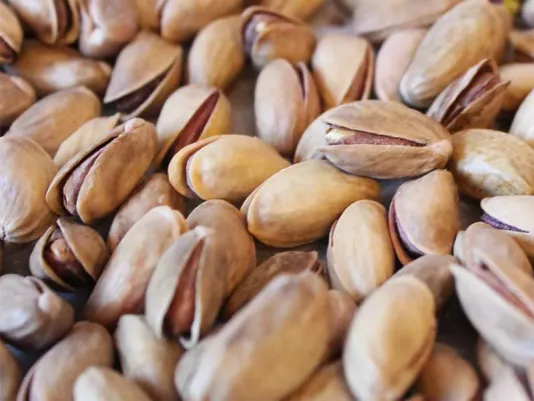Cold Pie with Pistachios
Cold pie with pistachios – an English cuisine recipe, the pie does not need to be baked and cook well in hot weather.

Pistachios have a natural oiliness that gives them special tenderness and makes them a beneficial addition to both sweet and savory dishes. Over years of cooking, I’ve learned that the quality of pistachios greatly affects the final result: fresh kernels have a rich aroma and firm structure, while old ones quickly turn bitter. In my practice, I always check the smell – it should be clean, nutty, and free of moisture. Such details immediately define the taste of creams, fillings, or sauces. It’s important to remember that pistachios are not just a decorative element but also a complete source of proteins and fats, so they should be used wisely. When stored and heated properly, they retain their signature color and pleasant oily texture.
When choosing pistachios, I always pay attention to three things: color, smell, and how much the shell has opened. Fresh kernels have a natural green or slightly yellowish tint without dark spots. If the shell is too white or shiny, it’s a sign of artificial bleaching, and such nuts lose part of their flavor. The smell should be light, oily, without bitterness or dampness. A strong aroma indicates spoilage or long storage in humid conditions. In my practice, I always buy pistachios in small batches and store them in tightly sealed jars away from spices and sunlight. When nuts are left open for too long, they absorb odors and quickly turn rancid. It’s equally important to check the edges of the shells: natural opening looks even, without chips. This means the nut ripened naturally, not mechanically forced. Such pistachios give the best texture in dishes and brown evenly when roasted, keeping a sweet note that’s prized in pastries and pastes.
Before adding pistachios to a dish, I always peel off their thin skin. It not only improves appearance but also softens the taste. To do this easily, I pour hot water over the kernels for a few minutes, then dry them and gently remove the skin by hand. I grind or chop the dry kernels depending on the recipe. If pistachios go into a cream or sauce, it’s best to dry them in the oven at 120°C (248°F) until a faint aroma appears – this activates the oils and deepens the flavor. In salads or dishes with fresh vegetables, I leave them raw to preserve tenderness. Over the years, I’ve learned that over-roasting destroys their natural color and makes them hard, so delicacy is key. If you need to grind pistachios into crumbs, I recommend cooling them first – this prevents excess oil release and keeps the mixture from sticking. This way, I always get a dry, crumbly texture that mixes easily with flour or powdered sugar for dough or decoration.
Pistachios are very sensitive to overheating. At too high a temperature, their oils begin to oxidize, creating bitterness that cannot be fixed. For roasting, I use medium heat and stir constantly. In the oven, I keep it under 160°C (320°F) and make sure the kernels don’t darken. It’s important not to let them reach a caramel tone – that’s fine for peanuts but not for pistachios, as they lose their softness. If I need to make paste, I warm them only for a few minutes so the structure remains elastic and they grind smoothly. Over years of preparation, I’ve noticed: it’s better to brown the kernels slowly than to rush the process. This makes the flavor richer without any hint of bitterness. For syrups or dessert creams, I add nuts at the end of heating so they don’t lose aroma. When making a hot sauce, I keep part of the nuts raw to preserve the color. Temperature control is the main secret to a stable flavor that stays consistent from batch to batch.
Pistachios pair well with creamy cheeses, citrus, white meat, and herbs like basil or mint. Their soft oiliness smooths acidity and adds roundness to the taste. In desserts, I combine them with lemon zest or vanilla – these aromas highlight the natural sweetness of the nut. In savory dishes, pistachios make an excellent contrast to smoked meats or aged cheeses. Over years of cooking, I’ve learned not to overload a dish: just a small handful creates textural balance. In salads, they add a pleasant crunch, and in sauces – creamy thickness. Finely ground pistachios form a base for coating chicken or fish, giving a golden color and subtle aroma. In my practice, I’ve noticed that pistachios don’t like too much salt – it’s better to let them reveal their natural flavor, making even the simplest dish seem refined. When paired with fruits, pistachios reveal a delicate floral profile that no other nut can imitate.
Most people ruin pistachios through improper storage or overheating. I always emphasize: heat, light, and moisture are the main enemies of these nuts. If you leave them in an open container in the kitchen, they’ll lose aroma and gain a bitter aftertaste within weeks. That’s why I store pistachios in tightly sealed glass jars in a cool, dark place, and in summer – in the fridge. It’s also important not to grind them in advance, since chopped kernels quickly absorb odors and oxidize. Another common mistake is over-roasting, when nuts darken and become brittle. If that happens, it’s better to use them in sauces rather than for decoration. Over years of experience, I’ve learned to recognize the perfect readiness: when pistachios start to crack slightly and release aroma, they’re done. You should also check the expiration date of purchased nuts – even airtight packaging won’t save them if they’ve been stored for over a year. Care and attention to detail ensure that pistachios remain tasty and nutritious longer.